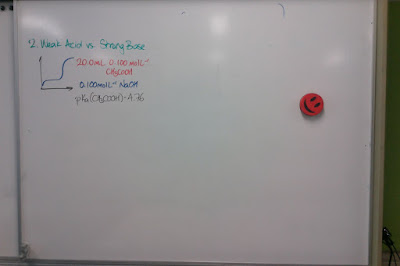Tuesday, 13 September 2016
Friday, 9 September 2016
Equivalence Point pH
STEP ONE: Write a balanced equation for what has happened at the equivalence point. This is not an equilibrium reaction, it is neutralisation.
STEP TWO: Use the n, c, V relationship to calculate the concentration of the conjugate being formed in the neutralisation reaction.
STEP THREE: Write an equation for the dissociation of the conjugate with water.
STEP FOUR: Use the weak base (or weak acid) calculations, as appropriate, to find the concentration of hydronium ions.
STEP FIVE: Use this concentration to calculate pH.
Buffers
The first things we need to master about buffers:
- Define a buffer
- Explain how a buffer works
- Calculate the pH of buffer solutions
On Mondays lesson, we can use our workbooks (Continuing Chemistry), and the internet as our resources, as well as the following videos:
Our next step is to work out how to make a buffer of a desired pH...
Tuesday, 6 September 2016
Titration Curves
During a titration, the pH does not change uniformly. There are key points that can be calculated, and the remainder of the curve can be sketched from these:
Initial pH
This example starts with a weak acid in the conical flask. If it were a weak base, the calculations are a lot harder, but you can refer to THIS for how to do that calculation.
Equivalence Volume and Half-Equivalence Point
This relies on a good memory of the titration topic from last year. Once you know the equivalence volume, you are ready to mark the pH of the half-equivalence volume (pKa = pH).
Final pH
This is very easy if you remember how to calculate the pH of a strong base (in this example). Put all of these points together to sketch the shape of the curve.
Weak Acid vs. Strong Base
Weak Base vs. Strong Acid
Subscribe to:
Comments (Atom)










